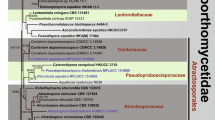Abstract
A new ascomycete genus, Achroceratosphaeria, is described for three lignicolous species from freshwater and terrestrial habitats in Asia and Europe on the basis of morphological studies and phylogenetic analysis of combined nc28S (LSU) and nc18S (SSU) rDNA sequence data. The new genus is characterized by minute, hyaline or subhyaline to pale brown perithecia immersed in the substratum with hyaline to subhyaline emergent necks. Paraphyses disintegrate with age, asci are cylindrical-clavate with a distinct apical annulus containing eight hyaline ascospores; ascospores are smooth-walled, ranging from ellipsoidal to fusiform to cylindrical-fusiform, without a mucilaginous sheath or appendages. All three species were obtained after incubation in a moist chamber. Achroceratosphaeria resembles Ceratosphaeria, Pseudohalonectria or Clohiesia in ascospore morphology, but molecular data do not support these relationships. In our phylogeny, a relationship between Achroceratosphaeria and taxa in the Lulworthiales and Koralionastetales is confirmed. Ceratosphaeria incolorata is transferred to Achroceratosphaeria and a new combination is proposed. A key to the species accepted in Achroceratosphaeria is provided.



Similar content being viewed by others
References
Campbell J, Inderbitzin P, Volkmann-Kohlmeyer B, Kohlmeyer J (2008) Koralionastetales, a new order of marine Ascomycota in the Sordariomycetes. Mycol Res 113:373–380
Cunningham CW (1997) Can three incongruence tests predict when data should be combined? Mol Phylogenet Evol 14:733–740
Gams W, Hoekstra ES, Aptroot A (eds) (1998) CBS course of mycology. Centraalbureau voor Schimmelcultures, Baarn, p 165
Gargas A, Taylor JW (1992) Polymerase chain reaction (PCR) primers for amplifying and sequencing nuclear 18S rDNA from lichenized fungi. Mycologia 84:589–592
Gutell RR (1993) Collection of small subunit (16S- and 16S-like) ribosomal RNA structures. Nucleic Acids Res 21:3051–3054
Gutell RR, Gray MW, Schnare MN (1993) A compilation of large subunit (23S and 23S-like) ribosomal RNA structures. Nucleic Acids Res 21:3055–3074
Hall TA (1999) BioEdit 5.0.9: a user-friendly biological sequence alignment editor and analysis program for Windows 95/98/NT. Nucleic Acids Symp Ser 41:95–98
Hebert TT (1971) The perfect stage of Pyricularia grisea. Phytopathology 61:83–87
Ho WH, Hyde KD (2001) A new family of freshwater ascomycetes. Fungal Diversity 4:21–36
Huelsenbeck JP, Ronquist F (2001) MrBayes: Bayesian inference of phylogenetic trees. Bioinformatics 17:754–755
Hyde KD (1995) Tropical Australian freshwater fungi. VII. New genera and species of Ascomycetes. Nova Hedwigia 61:119–140
Hyde KD, Read SJ, Jones EBG, Moss ST (1997) Tropical Australian freshwater fungi. XII. Rivulicola incrustata gen. et sp. nov. and notes on Ceratosphaeria lampadophora. Nova Hedwigia 64:185–196
Jones EBG, Sakayaroj J, Suetrong S, Somrithipol S, Pang KL (2009) Classification of marine Ascomycota, anamorphic taxa and Basidiomycota. Fungal Diversity 35:1–187
Kauff F, Lutzoni F (2002) Phylogeny of the Gyalectales and Ostropales (Ascomycota, Fungi): among and within order relationships based on nuclear ribosomal RNA small and large subunits. Mol Phylogenet Evol 25:138–156
Landvik S (1996) Neolecta, a fruit-body-producing genus of the basal ascomycetes, as shown by SSU and LSU DNA sequences. Mycol Res 100:199–202
Larget B, Simon DL (1999) Markov chain Monte Carlo algorithms for the Bayesian analysis of phylogenetic trees. Mol Biol Evol 16:750–759
Posada D, Crandall KA (1998) Modeltest: testing the model of DNA substitution. Bioinformatics 14:817–818
Ranghoo MV (1998) Phylogeny of freshwater ascomycetes. PhD. Thesis, University of Hong Kong
Ranghoo MV, Hyde KD, Liew ECY, Spatafora JW (1999) Family placement of Ascotaiwania and Ascolacicola based on DNA sequences from the large subunit rRNA gene. Fungal Diversity 2:159–168
Ranghoo MV, Hyde KD, Wong SW, Tsui CKM, Gareth Jones EB (2000) Vertexicola caudatus gen. et sp. nov., and a new species of Rivulicola from submerged wood in freshwater habitats. Mycologia 92:1019–1026
Réblová M (1998) Fungal diversity in the Czech Republic. New species of Apiorhynchostoma, Capronia, Ceratosphaeria and Lasiosphaeria. Sydowia 50:229–251
Réblová M (2006) Molecular systematics of Ceratostomella sensu lato and morphologically similar fungi. Mycologia 98:63–93
Rehner S, Samuels GJ (1994) Taxonomy and phylogeny of Gliocladium analysed from nuclear large subunit ribosomal DNA sequences. Mycol Res 98:625–634
Spatafora JW, Mitchell TG, Vilgalys R (1995) Analysis of genes coding for small-subunit rRNA sequences in studying phylogenetics of dematiaceous fungal pathogens. J Clin Microbiol 33:1322–1326
Swofford DL (ed) (2002) PAUP*. Phylogenetic Analysis Using Parsimony (*and Other Methods). Version 4. Sinauer, Sunderland
Vilgalys R, Hester M (1990) Rapid genetic identification and mapping of enzymatically amplified ribosomal DNA from several Cryptococcus species. J Bacteriol 172:4238–4246
Vilgalys R, Sun BL (1994) Ancient and recent patterns of geographic speciation in the oyster mushroom Pleurotus revealed by phylogenetic analysis of ribosomal DNA sequences. Proceedings of National Academy of Sciences, USA 91:4599–4603
White TJ, Bruns T, Lee S, Taylor J (1990) Amplification and direct sequencing of fungal ribosomal RNA genes for phylogenetics. In: Innis MA, Gelfand DH, Sninsky JJ, White TJ (eds) PCR protocols: A guide to methods and applications. Academic, San Diego, pp 315–322
Wong SW, Hyde KD, Jones EBG (1998) Annulatascaceae, a new ascomycete family from the tropics. Systema Ascomycetum 16:17–24
Zhang Y, Fournier J, Pointing SB, Hyde KD (2008) Are Melanomma pulvis-pyrius and Trematosphaeria pertusa congeneric? Fungal Diversity 33:47–60
Zhang Y, Wang HK, Fournier J, Crous PW, Jeewon R, Pointing SB, Hyde KD (2009) Towards a phylogenetic clarification of Lophiostoma/Massarina and morphologically similar genera in the Pleosporales. Fungal Diversity 38:225–251
Acknowledgements
This study was supported by the Project of the National Foundation of the Czech Republic (206/09/0547) and Institutional Research Concept No. AV0Z60050516 (Institute of Botany of the ASCR). We are grateful for help of Dr Václav Štěpánek, who undertook the DNA sequencing of the ascospore isolate of Achroceratosphaeria potamia and other newly presented sequences.
Author information
Authors and Affiliations
Corresponding author
Rights and permissions
About this article
Cite this article
Réblová, M., Fournier, J. & Hyde, K.D. Achroceratosphaeria, a new ascomycete genus in the Sordariomycetes, and re-evaluation of Ceratosphaeria incolorata. Fungal Diversity 43, 75–84 (2010). https://doi.org/10.1007/s13225-010-0032-6
Received:
Accepted:
Published:
Issue Date:
DOI: https://doi.org/10.1007/s13225-010-0032-6




